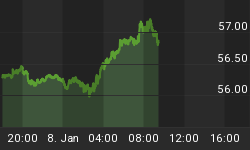Here is an extract from commentary posted at www.speculative-investor.com on 20th July 2003:
The bond-dollar relationship is one of the most important inter-market relationships 'on the go' at the moment and (we think) contains some important clues regarding what to expect from the financial markets over the next few months.
In our 30th June commentary we discussed the fact that the bond-dollar relationship has not been consistent over the past 25 years in that bonds and the dollar have trended in the same direction for extended periods and moved in opposite directions during other periods. As the following chart shows, though, since the beginning of 2002 there has been a strong inverse correlation between the Dollar Index and the US T-Bond price.

The inverse correlation illustrated in the above chart has occurred for a number of reasons, one of which is the behaviour of foreign (non-US) central banks in general and the Bank of Japan in particular. This is because the countries that rely heavily on exporting goods to the US do not want their currencies to appreciate against the dollar. Therefore, as the dollar weakens the central banks of these countries intervene in the currency market by purchasing dollars using their own currency (which they can create out of thin air). The dollars purchased as a result of these interventions are then invested in US Treasury or Agency debt in order to earn some interest income. In other words, in the current environment every drop in the US$ indirectly stimulates foreign central bank demand for US bonds. Correspondingly, when the dollar stabilises or starts to rise there is no need for currency-market intervention on the part of foreign central banks and one of the major components of the demand for US bonds is immediately removed.
As an aside, Richard Duncan described another important aspect of the currency market manipulation undertaken on a routine basis by central banks throughout the world in his recent article titled "Asia, its reserves and the coming dollar crisis" which can be read at
Getting back to the above chart, notice how the March-June plunge in the dollar was accompanied by a surge in the T-Bond price but as soon as the dollar began to rebound, the bond price crashed. The question is: Will this inverse relationship continue?
We don't see any reason why it won't continue for at least a few more months. It is certainly likely that foreign central banks will continue to try to prevent the US$ from falling too far, too fast, so we expect that any significant decline in the US$ will lead to the Bank of Japan and other central banks making large purchases of US Government and Agency debt. Furthermore, such purchases will probably be sufficient to push the T-Bond price higher between now and the time when the US inflation problem is more widely recognised. It is also likely that foreign central banks would have a much smaller presence in the bond market if the dollar's rebound continued for a few more months. And, without the support of foreign central banks US bond prices would most likely fall under the weight of their own over-valuation.
The price action suggests that bonds have either already reached a short-term low or are very close to doing so. It wouldn't be a surprise if slightly lower levels were reached over the coming month, but we expect that the next tradable move in bonds (for those who trade the multi-month swings) will be to the upside. However, if the inverse relationship between bonds and the dollar is still in effect then this bond-market view only makes sense if the dollar is going to commence another multi-month decline at some point over the next few weeks. Interestingly, the market action towards the end of last week [the week ending on 18th July] provided us with some preliminary evidence that another dollar decline has begun. In other words, the pieces of the puzzle are starting to fit together rather nicely.
















